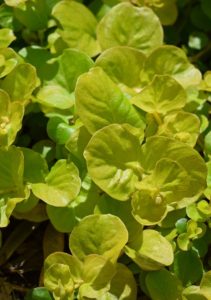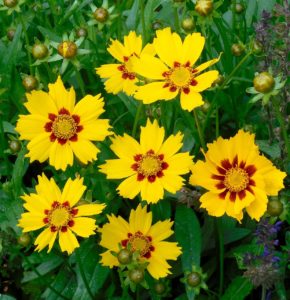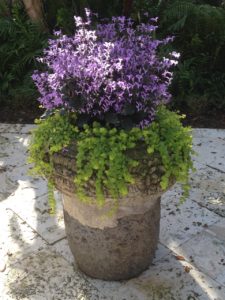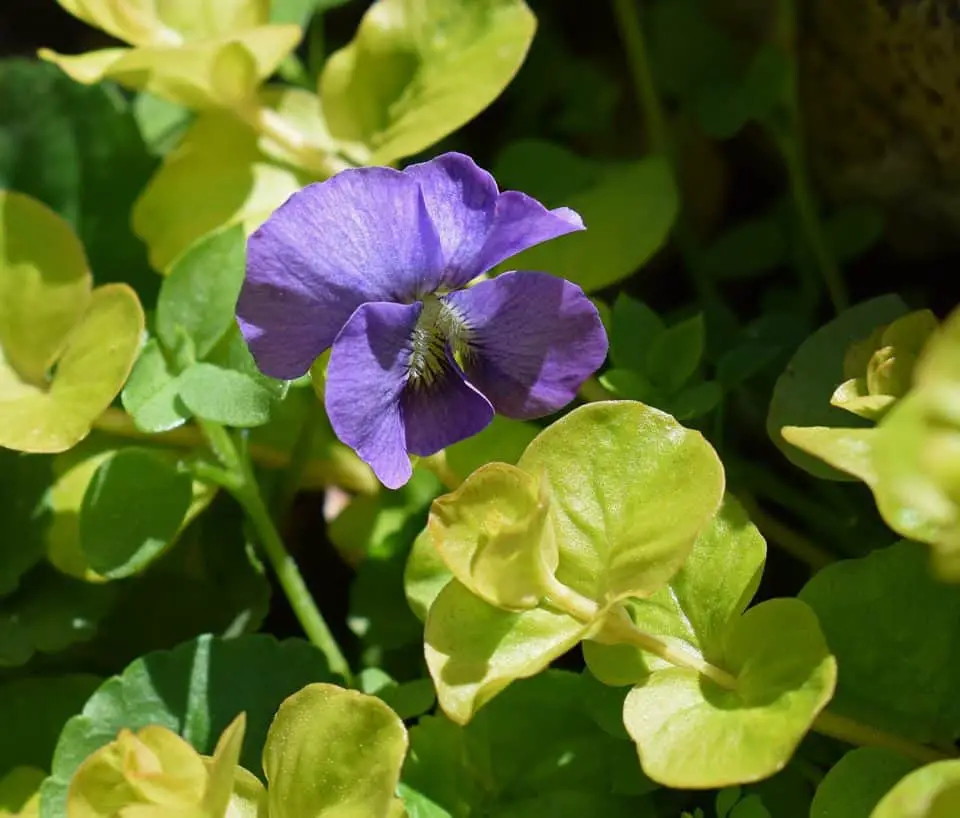Some links in the post are affiliate links and I get a commission from purchases made through some links found in the post.
Groundcover comes with tons of advantages. These include protecting the environment from soil erosion, imparting positive aesthetic effects, and creating an ideal home for helpful microorganisms.
These are but some of the many ways we can use groundcover in our homes. Of course, we always want a bit of that extra beauty when settling on groundcover, which is why creeping jenny has become such a hit.
The creeping jenny, scientifically known as Lysimachia Nummularia, is a groundcover plant with green foliage with single yellow flowers per plant.
The beautiful contrast between the green and yellow makes it a stunning plant that’s perfect for any yard. Take the golden creeping jenny, for example.
A single plant spreads about 12 to 18 inches with stems as long as 6 inches. This coverage, coupled with the beauty of its flowers, has propelled its growth as one of the most sought-after ornamental plants.
You may have heard of its other names- moneywort and twopenny grass. We cover how you can plant it, what makes it different from other plants, and what you can do about its possible invasiveness.
What Are Good Companion Plants For A Creeping Jenny?
 One thing you should note about the creeping jenny is that it spreads fast. Give it favorable conditions, and in no time, your once empty yard will look like a landscape from a magazine.
One thing you should note about the creeping jenny is that it spreads fast. Give it favorable conditions, and in no time, your once empty yard will look like a landscape from a magazine.
Unfortunately, this also brings out the aspect of invasiveness. As the creeping jenny makes its way around your yard, it’s known to be invasive and can choke out the native plants in your yard.
How? By producing specialized roots and shoots that develop into new plants.
Good companion plants we recommend planting creeping jenny with are the following:
Ornamental Grasses
These grasses boast beauty, strength, and the ability to spread almost as fast as the creeping jenny.
This healthy competition will ensure that neither gets the upper hand, and you can enjoy some diversity in your yard. Examples include:
Mexican Feather Grass
Like the creeping jenny, this species also has invasive traits. So, you can look forward to a bit of competition between the plants.
Keep in mind that you’ll need to contain the grass to keep it from taking over other parts of the yard.
Bamboo
If you want a fast spreader that will also enhance the beauty of your yard, this works.
Bamboo plants establish a robust root system that even creeping jenny plants cannot outdo. You can rest assured that the competition will not get out of hand.
Japanese Blood Grass
This species is native to Asia, Africa, Australia, and Melanesia.
Its beauty makes it a frontrunner for this companion role. Given its possible invasiveness, you might need a state permit to grow its cultivars.
When choosing ornamental grasses, you must consider if they tend to spread or clump. It affects the overall look of the yard and how striking the creeping jenny will look in relation to its surroundings.
Daylily
Another of the good companion plants for a creeping jenny is a daylily. This ornamental plant produces beautiful orange flowers that last a day. Interestingly, one plant can have as many as 400 blooms in a month.
Picture that combined with the beautiful yellow flowers from your creeping jenny and your landscape is one for the books.
One key benefit of these plants is their hardiness- once they establish, you barely need to lift a finger to get them to thrive.
Their vigorous growth is another upside- they grow to heights of four feet with round stems with leaves as long as three feet which curve towards the ground.
Every three or four years, you can divide the plants, grow the new ones, or share them with your friends. Moreover, their thick tuberous roots give rise to new plants.
Please note that some daylily varieties are considered ecological threats. You must practice caution when choosing the right one for your yard based on your zone.
Coreopsis
 How about adding some more hue to your yard? Adding Coreopsis is a great way to do so. This plant genus, also known as tickseed, is similar to the daisy and gives rise to brightly colored flowers.
How about adding some more hue to your yard? Adding Coreopsis is a great way to do so. This plant genus, also known as tickseed, is similar to the daisy and gives rise to brightly colored flowers.
Under it are 80 species of perennials that boast adaptability and tall, fluffy builds. Some of the best varieties to consider include:
Coreopsis Grandiflora
This species grows by both seed and division but will not take over the yard. Instead, it will introduce a healthy competition to keep the creeping jenny from being the only point of interest.
Coreopsis Verticillata ‘Moonbeam’
This plant tends to travel in the yard and can pop up in places where you had not initially planted it.
Its foliage falls back a bit in relation to its white flowers with yellow centers that create quite a picture.
This aesthetic, coupled with the creeping jenny’s bold green and yellow hues, would create quite a sight.
Coreopsis Verticillata ‘Golden Showers’
This species is tolerant to dry weather and can survive long periods without water. If you don’t want the moonbeam for its traveling properties, you can choose this plant which tends to clump in one spot.
There are tons of other Coreopsis plants to choose from, and you can find the one that meshes with your gardening theme.
If you’re enjoying this article, check out our article on 5 great planting combinations with your Agapanthus.
Will Creeping Jenny Choke Out Other Plants?
Like with other invasive species, this plant is not native to North America. Instead, it is native to Europe and found its way to North America via introduction in the early 1700s.
So yes, it will compete with your native plants for space and nutrients. While hardy plants like ornamentals and daylilies can withstand such competition, most native plants cannot.
If you plan on planting the creeping jenny on the ground, here is what you should know:
The creeping jenny was introduced to North America as a horticultural groundcover. For the most part, it still serves this role and is widely sold as such in nurseries.
Even so, recent studies have proven that this plant has invasive tendencies. For one, it is highly adaptable to a wide range of growing conditions.
However, it does best in rich, moist, and shaded soils where it can spread with ease. That’s why it’s become problematic in wet and cold environments like swamps and forested areas.
Secondly, this plant tends to form dense mats. When these are in wetlands, they disrupt the ecology by preventing other species from accessing nutrients.
Moreover, its adaptability is much higher than that of other species in wetland regions. This upper hand makes it easier for it to dominate such environments and slowly choke out other plants.
We advise that you use it on hard ground and avoid using it near wetland areas where it could escape into the environment and wreak havoc.
Moreover, you should contain its growth to your yard and ensure that any traveling plants are cut off and disposed of properly. Also, plant the less aggressive species like the ‘Aurea’ and ‘Goldilocks,’ which will not take over your yard.
Does Creeping Jenny Prefer Sun or Shade?
Are you wondering if the creeping jenny is right for your yard? This plant thrives in USDA zones 3-9. Like we earlier mentioned, it does well in a range of conditions.
But if you can provide it with consistently moist soil, it would thrive. However, this should not be in wetland regions where it can disrupt the ecology.
But in a regulated pond or other artificial source of water in your yard, this plant would grow well and would spread by seeding and rooting in all places where it touched soil.
But how about the sun? If you want to see the creeping jenny in full bloom, you can plant it in full sun. That’s when the beauty of its flowers and foliage shows in full effect.
You can also make do with partial shade or sun. In this case, the leaves would feature a dark green instead of a light-yellow hue.
The plant still does well in full shade, but you don’t get to see all the hues. Even so, the temperatures should not fall below -30° to -20°F (-34° to -29°C).
Also, on this, keep the soil moist by regularly watering it. Else, the plant will not bloom, and you will not revel in its beauty.
Will Creeping Jenny Come Back Every Year?
 The creeping jenny is a herbaceous perennial plant that will regrow every spring so it will come back every year. The good news is that the roots can withstand winter conditions.
The creeping jenny is a herbaceous perennial plant that will regrow every spring so it will come back every year. The good news is that the roots can withstand winter conditions.
You don’t need to uproot the plant to save it for the next season. But the leaves and shoots will die back after a while during winter.
You can trim them before the temperatures fall to their lowest, or you can let nature do its thing and watch them die back.
If the plant is in a pot, you can move this indoors where you have better control over the shoots, which you can use to propagate more plants.
Outdoor plants will survive, and in spring, they will give rise to new shoots in readiness for the new season.
Final Thoughts: What Are Good Companion Plants For A Creeping Jenny?
Did you know that creeping jenny leaves and flowers are edible? That’s right! Now and then, you can make a hot brew from these plant parts for their antioxidant benefits. Happy Gardening!
Before you go, here are some more related articles I encourage you to read below to help solve more of your gardening issues:
What to plant with coleus in a container.


